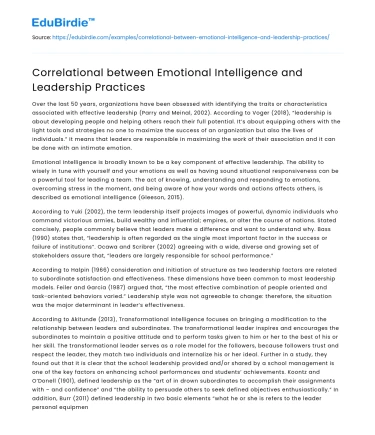Over the last 50 years, organizations have been obsessed with identifying the traits or characteristics associated with effective leadership (Parry and Meinal, 2002). According to Voger (2018), “leadership is about developing people and helping others reach their full potential. It’s about equipping others with the light tools and strategies no one to maximize the success of an organization but also the lives of individuals.” It means that leaders are responsible in maximizing the work of their association and it can be done with an intimate emotion.
Emotional Intelligence is broadly known to be a key component of effective leadership. The ability to wisely in tune with yourself and your emotions as well as having sound situational responsiveness can be a powerful tool for leading a team. The act of knowing, understanding and responding to emotions, overcoming stress in the moment, and being aware of how your words and actions affects others, is described as emotional intelligence (Gleeson, 2015).
Save your time!
We can take care of your essay
- Proper editing and formatting
- Free revision, title page, and bibliography
- Flexible prices and money-back guarantee
According to Yuki (2002), the term leadership itself projects images of powerful, dynamic individuals who command victorious armies, build wealthy and influential; empires, or alter the course of nations. Stated concisely, people commonly believe that leaders make a difference and want to understand why. Bass (1990) states that, “leadership is often regarded as the single most important factor in the success or failure of institutions”. Ocawa and Scribrer (2002) agreeing with a wide, diverse and growing set of stakeholders assure that, “leaders are largely responsible for school performance.”
According to Halpin (1966) consideration and initiation of structure as two leadership factors are related to subordinate satisfaction and effectiveness. These dimensions have been common to most leadership models. Feiler and Garcia (1987) argued that, “the most effective combination of people oriented and task-oriented behaviors varied.” Leadership style was not agreeable to change: therefore, the situation was the major determinant in leader’s effectiveness.
According to Akitunde (2013), Transformational Intelligence focuses on bringing a modification to the relationship between leaders and subordinates. The transformational leader inspires and encourages the subordinates to maintain a positive attitude and to perform tasks given to him or her to the best of his or her skill. The transformational leader serves as a role model for the followers, because followers trust and respect the leader, they match two individuals and internalize his or her ideal. Further in a study, they found out that it is clear that the school leadership provided and/or shared by a school management is one of the key factors on enhancing school performances and students’ achievements. Koontz and O’Donell (1901), defined leadership as the “art of in drown subordinates to accomplish their assignments with – and confidence” and “the ability to persuade others to seek defined objectives enthusiastically.” In addition, Burr (2011) defined leadership in two basic elements “what he or she is refers to the leader personal equipment, his or her personality character and reference”. And the “what he or she uses refers to his or her performance leadership styles or behavior”. Instructional leaders in their schools even could be seen as having an ethical purpose to straightforward vision where the school for all children and youth by developing strong commitments to important things and modeling and supporting them continuously.
Sergiovanni (2007), indicates transactional leadership focuses supervision skills such as rules, procedures and job description to accomplish expectations. Schneider (1992) asserted the leadership is a learned behavior. Delos Santos (2002), categorized certain outstanding track of leaders in the military organization, these leadership characteristics are “shakers” and “owners”. He said that leaders tend to achieve significant milestones and passionately pursue their mission if the subordinate are to lead their lives with a sense of destiny. They can stay on course and develop patterns of excellence and achievements.
Goleman said “to process emotional information and utilize it effectively whether to facilitate good personal decisions to resolve conflicts or to motivate oneself and other. Emotional Intelligence is everywhere we look, and without it, we would be devoid of a key part of human experience. And according to Dollar (2018), “No matter what leader set out to do whether it’s creating a strategy or mobilizing teams to action their success depends on how they do it. Even if they get everything else just right, if leaders fail in this primal task of driving emotions in the right direction nothing they do will work as well as it could or should.” According to Palmer et. al (2000) and some researchers in psychology, they use the emotional intelligence examination in predicting the effectiveness of a leader and also, the emotional intelligent leaders are believed to be more joyful and progressively dedicated to their association. Research into the relationship between emotional intelligence and transformational leadership is filled with bold claims as to the relationship between these constructs (Harms and Crecle). Noted experts in the field of emotional intelligence argue that elements of it such as empathy, self-confidence and self-awareness are the core under pinning of visionary or transformational leadership.
According to Waters, Marzano, and McNulty (2003), effective leadership is best described as balanced and thorough. Effective leaders have a discerning ability to know when, how, and what needs to be done. Further still, the significance of emotional intelligence in a senior leadership role such as a department chair, dean, or college/ or university president should not be trivialized. In the late 1980s, research confirmed that emotional intelligence was correlated with nearly 90% of effective leadership practices (Salovey & Mayer, 1990).






 Stuck on your essay?
Stuck on your essay?

